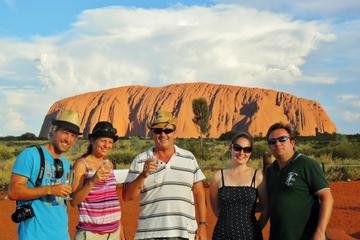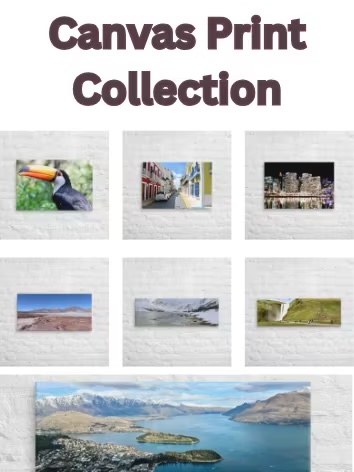Uluru – Kata Tjuta Tour – Emu Run Experience

The Ultimate Uluru Adventure - Alice Springs to Uluru with Emu Run Experience
I embarked on an extraordinary 16-hour journey with Emu Run Experience, journeying from Alice Springs to the iconic Uluru and Kata Tjuta. This immersive tour offered a unique opportunity to experience the magic of the Red Centre. The trip to Uluru was on a comfortable, air conditioned bus. As the journey progressed, I enjoyed the engaging commentary from our knowledgeable guides who brought the Red Centre to life.

Emu Run Experience - Comfort and Knowledge
I commenced my day with an early morning pickup at the Doubletree Hotel. Anticipating a lengthy drive, I opted for the Big Front Seat (an additional A$25.) A stop at the Mount Conner Lookout provided a breathtaking introduction to the vastness of the Australian outback.

Immersed in the Outback
Upon arriving at Uluru-Kata Tjuta National Park, I delved into the rich tapestry of Aboriginal culture at the Cultural Centre. I explored the iconic Uluru, venturing to the Mutitjulu Waterhole and embarking on the Mala Walk. A visit to the stunning Walpa Gorge within Kata Tjuta was a highlight.

All-Inclusive Experience
For a cost of S$299 ($195), the tour included delicious meals, refreshing snacks, and the national park entrance fee, allowing me to focus solely on the adventure. A highlight was the unforgettable experience of enjoying a barbecue dinner buffet while watching the sun paint Uluru in hues of orange and red.

Essential Gear
To fully enjoy the experience, I recommend packing a water bottle, sturdy walking shoes, a wide-brimmed hat, a fly net (essential!), sunglasses, a camera, a USB charger, and a travel pillow.


How to Book the Tour - Emu Run Experience - Alice Springs to Uluru
I am 99% sure that this package below is my exact tour. As an affiliate partner with Viator, I may receive a small commission at no additional cost to you. If you are interested in this tour, I’d appreciate you booking through this link. If you prefer to book directly, you may also book directly with Emu Run.
The price of this tour is accurate as of August 2024.
 | Ayers Rock Day Trip from Alice Springs Including Uluru, Kata Tjuta and Sunset BBQ Dinner - $234.99 Journey into the heart of Central Australia with two expert guides to experience the wonders of Uluru (Ayers Rock) and Kata Tjuta National Park, sacred sites of the local Aboriginal people. Explore the spectacular scenery around Uluru, Kata-Tjuta, enjoy the Mutitjulu Waterhole and Mala guided walks and visit the Cultural Centre to learn about Aboriginal traditions and history. This all-inclusive tour includes buffet breakfast at Erlanda Roadhouse and lunch, an Aussie barbecue during the sunset at Uluru and snacks throughout the day. |
Uluru Kata Tjuta National Park Tour with Emu Run - Table of Contents

- About the Uluru/Kata Tjuta National Park Tour
- Stops On the Tour of Uluru/Kata Tjuta with Emu Run
- A Call for Respect
- Support Buzzin’ Around the World – Visit Our Affiliates
- Earning Points and Rewards
- Related Content
Disclaimer: Buzzin’ Around the World strives to provide accurate and up-to-date information based on our research at the time of publication. We respect all applicable laws and fair use principles. If you believe any information is incorrect or violates regulations, please contact us at buzzinaroundtheworld@gmail.com.
Affiliate Links and Reviews: We use affiliate links to generate income and may receive a commission at no additional cost to you when you use our links. We strive for honest and transparent reviews, even for products which we receive compensation.
Content Creation: Our content is based on our own travel experiences. All photos are our own unless otherwise stated. We sometimes utilize AI tools to assist with tasks like generating titles, summarizing content, and improving organization.
For more information: For more information, please click HERE to visit our private policy page. We can be reached at buzzinaroundtheworld@gmail.com.
Alice Springs to Uluru - Our First Stop: Erldunda
Two hours into our epic journey, we made our first pit stop at the charming outback town of Erldunda. Renowned as “The Home of the Emu,” this small oasis offered a welcome respite from the open road.

Outback Breakfast
A classic outback roadhouse, Erldunda boasts a hotel, gas station, and restaurant, all surrounded by the vast expanse of the Australian desert. We indulged in a hearty breakfast of eggs, bacon, sausage, and toast, which was the perfect fuel for the remainder of our adventure.
Exploring Erldunda
After satisfying our appetites, we had a few moments to explore the quaint gas station market and encounter the town’s namesake, the emu. It’s worth noting that Erldunda is the last opportunity to purchase a fly net, an essential item for your outback exploration.
Onward to Mount Conner
With renewed energy, we continued our journey, the open road lulling us into a peaceful slumber as we anticipated our next destination: the iconic Mount Conner Lookout.

Mount Conner Lookout: A Desert Oasis
After a restful slumber on the bus, we arrived at the Mount Conner Lookout. Often mistaken for Uluru due to its similar appearance, Mount Conner is a captivating sight.

Exploring the Surroundings
While we didn’t venture close to the mountain, the lookout provided a perfect opportunity to stretch our legs and capture the moment. A short walk across the road led us to a stunning salt lake, its pristine white surface contrasting beautifully with the surrounding red sands. The stark beauty of the landscape was truly mesmerizing.

Back on the Road
Refreshed and rejuvenated, we boarded the bus once more, our anticipation growing as we approached the final leg of our journey: Uluru-Kata Tjuta National Park.
Arriving at Uluru-Kata Tjuta National Park
Entering the Park
After an additional two hours of driving, we finally reached the gates of the Uluru-Kata Tjuta National Park. Thanks to our tour including the park entrance fee, we swiftly entered the park, our anticipation building.
Cultural Immersion
In addition to exploring Uluru and Kata Tjuta, our itinerary included a visit to the Aboriginal Culture Centre. It’s essential to learn about the Anangu people, the traditional owners of this sacred land. Since 1985, Uluru has been officially returned to the Anangu people, making it crucial to respect their culture and heritage.
A Quiet Encounter
Before entering the park, we enjoyed a chicken salad wrap for lunch. Surprisingly, the park was relatively quiet for such a beautiful day. As we embarked on the 15-minute drive to the base of Kata Tjuta, a sense of wonder filled the air.

Kata Tjuta: A Geological Marvel
The Olgas
Kata Tjuta, also known as the Olgas, is a breathtaking collection of 36 domed rock formations. Towering at 3,497 feet, Mount Olga is the highest peak, surpassing Uluru in height and offering a distinct geological profile.

Walpa Gorge: A Natural Wonder
Our sole stop at Kata Tjuta was the mesmerizing Walpa Gorge. A 2.5-kilometer trail led us into this natural wonder. We were allotted 45 minutes to explore its depths. To ensure a timely return, I set a 20-minute alarm. When the timer went off, I would have to start walking back to the bus.


A Hike Through Time
The trail, while rocky and inclined, was manageable. As I ventured deeper into the gorge, I was captivated by the extraordinary colors of the rock formations. The vibrant reds and oranges were far more intense than I had imagined.

Nature's Artistry
One particular scene stood out: a trail of lush green grass contrasting sharply against the fiery red rocks. This unexpected burst of life added a touch of magic to the landscape. The gorge’s walls were adorned with fascinating holes and crevices, remnants of millions of years of weathering.

Aboriginal Dreamtime Stories
The Aboriginal people have woven intricate tales around these geological formations. According to their legends, giant snakes, lizards, and wallabies shaped the land, leaving their mark on the rock face. Our guide, Michael, shared these captivating stories, bringing the ancient past to life.


Back to the Bus
My strategy proved successful, as I returned to the bus just as my allotted time expired. Unfortunately, some of my fellow travelers were still exploring the gorge.
A Journey Through Culture - The Aboriginal Culture Centre
Our next stop was the enlightening Aboriginal Culture Centre. Unfortunately, photography was prohibited inside,preventing me from capturing the rich displays. The centre itself was a marvel, constructed from locally sourced mud bricks, reflecting the harmonious blend of culture and environment.
Immersed in the world of the Anangu people, I explored interactive exhibits that unveiled the intricacies of their history and traditions. The centre offered a profound understanding of their deep connection to the land.
As a souvenir, I acquired a beautifully carved wooden lizard and a captivating woodblock painting, supporting local artists and preserving cultural heritage.
After spending a contemplative 45 minutes at the centre, we embarked on the final phase of our journey: two walking tours of Uluru.

A Glimpse into the Past: Uluru's Mutitjulu Waterhole
A Sacred Oasis
Our first encounter with Uluru’s magic unfolded at the Mutitjulu Waterhole, a vital lifeline in this arid landscape. Accompanied by our knowledgeable guide, Michael, we embarked on a journey through time.

Ancient Art Revealed
Our exploration began with a mesmerizing display of Aboriginal rock art concealed within a natural rock formation.Despite the fading of these ancient paintings due to past preservation methods, the remnants offered a profound connection to the past.

Michael shared poignant tales of the Anangu people and their deep spiritual connection to the land. The use of ochre, a mineral mined locally, added another layer of intrigue to these prehistoric masterpieces.


The Heart of the Land
We then approached the waterhole itself, a serene oasis amidst the rugged terrain. The sun’s rays filtering through the rock created a magical atmosphere, although it hindered photography.

Despite the challenge, I managed to capture a few glimpses of this sacred site. As we wandered, I noticed intriguing rock formations, including a heart-shaped rock and another adorned with unique markings.
Unfortunately, my camera’s memory reached its limit, forcing me to postpone further photography until returning to the bus.



The Mala Walk: A Cultural Journey at Uluru
A Walk Through Time
Our final stop at Uluru was the Mala Walk, a journey through time and culture. Commencing at the Mala Car Park, this trail is named after the indigenous Mala people who once thrived in this region. Due to the sacred nature of certain areas, photography was restricted, limiting my ability to capture the full essence of this experience. All of the photographs below were taken with permission from areas where photographs were allowed.

Ancient Stories Unveiled
The first stop was the “woman’s cave,” a repository of Aboriginal art. Depictions of animals and footprints offered glimpses into the daily life of the Mala people. Our guide, Michael, shared captivating tales about their existence, bringing the past to life.


Kurpany - The Devil Dog
One particularly captivating tale involved the legendary Devil Dog, Kurpany, whose footprint is said to be imprinted on the cave wall. This mythical creature was sent by rival tribes to decimate the Mala people, a cautionary tale emphasizing the importance of unity and vigilance.
Recalling the Story of Kurpany, The Devil Dog
I will try my best to recall the story as it was told. The Devil Dog legend explains the reason for the giant footprint that is indented in the rock of the woman’s cave. The footprint resembles that of a dog.
When the Mala people originally came to the area that surrounds Uluru, they saw the rock (Uluru) from a distance and thought it would be a great place to live. Before this land became their new home, the Mala wanted to have a ceremony called an Inma. An Imna officially starts once a ceremonial flag pole, called a Ngaltawata, has been raised. To prepare for the Imna, everyone had a role. The women gathered food while the men hunted.
As the preparations continued, two men from the Wintalka People approached the Mala and asked them to stop their Inma. The men wanted them to join the Wintalka in a similar celebration. The Mala explained that since their flag pole had already been erected, they were unable to stop their ceremony. The men from the Wintalka People left disappointed, returning home to explain that the Mala had rejected their invitation.
Upon returning home, the Wintalka were furious that their invite had been declined. To retaliate, a Devil Dog named Kurpany was created to destroy the Mala. According to Michael, the Devil Dog can take other forms, such as a spirit or a ghost. As the Devil Dog headed towards Uluru, a woman spotted Kurpany and warned the Mala people. The Mala ignored her warning, and Kurpany attacked and killed many of the Mala. The legend of Kurpany explains how the footprints were imprinted into the cave.
The moral of this story is to always finish what you begin and to listen to and take seriously the warnings of dangers.


Exploring the Mala Trail
With 45 minutes to explore independently, I ventured deeper into the Mala Walk. The trail unfolded as a photographer’s dream, offering stunning vistas. To ensure I returned to the bus on time, I managed my time carefully. Despite the allure of the surroundings, I had to resist the temptation to linger.

With the walk complete, I rejoined the group, eager to share my discoveries. Our final stop was a sunset barbecue,promising breathtaking views of Uluru.
A Spectacular Sunset Finale at Uluru
Our final stop was a magical sunset barbecue. A short drive brought us to a picturesque viewing area, perfectly positioned to witness the breathtaking transformation of Uluru. As we arrived, Gavin, our other dedicated guide, was already preparing a hearty feast.



A Desert Feast
The barbecue spread featured hot dogs, steak sandwiches, and a variety of salads, providing a satisfying meal after a long day of exploration. While not gourmet cuisine, the food was hearty and much appreciated.
Nature's Masterpiece
The true star of the evening was Uluru itself. As the sun began its descent, the monolith was bathed in a kaleidoscope of colors, from fiery reds to deep purples. I set up my tripod to capture this extraordinary spectacle through time-lapse photography.
The Journey Home
As the sun dipped below the horizon, casting its final hues upon Uluru, our extraordinary adventure drew to a close. A farewell barbecue under the starlit sky provided a fitting end to a day filled with wonder and discovery.
With heavy hearts but fulfilled spirits, we boarded the bus for the long journey back to Alice Springs. A brief respite at Erldunda offered a welcome break from the open road. Arriving at my hotel around 11:45 PM, exhaustion washed over me as I sank into bed, ready to recharge for the next leg of my Australian adventure.
A Call for Respect
While the tour itself was exceptional, a troubling observation marred the experience. Despite clear guidelines and requests from the Anangu people, the traditional owners of Uluru-Kata Tjuta National Park, some visitors exhibited a blatant disregard for their wishes. Climbing Uluru, a sacred site, and venturing off designated paths are disrespectful acts that undermine the cultural significance of this place.


It is imperative that visitors to this extraordinary region adhere to the guidelines set forth by the Anangu people. By respecting their wishes, we ensure the preservation of this precious land for generations to come. It was extremely disheartening to see people still climbing Uluru.


Affiliate Partner of the Month – Fourthwall
Fourthwall powers our brand-new Buzzin’ Around the World Merch Shop. Pick up a tee, hoodie, or sticker. All profits will help me continue to run this site and deliver great content!
Buzzin Around the World's Merch Shop
Want to Launch Your Own Merch Line?
Scroll to the bottom of our Fourthwall page and tap “Start Your Own Store.” That’s a referral link—if you sign up, Fourthwall rewards me with store credit I can use to buy more gear (at no extra cost to you). We only recommend tools we use and love.
Earn $200 in Travel Rewards with the Capital One VentureOne Rewards Card
The Capital One VentureOne Rewards Card is one of the few rewards cards that does not charge an annual fee. Cardholders can earn 1.25 points for every dollar spent while enjoying 0% APR for 15 months.
Currently, Capital One is offering a signup bonus of 20,000 points (worth $200 in travel rewards) when the cardholder spends $500 in the first three months. If you are interested in this card, I would appreciate it if you would sign up with the link below, as I earn a referral bonus of 10,000 points. Those points are worth $100 in travel rewards and will help me continue to bring great content to Buzzin’ Around the World.
Once again, the Capital One VentureOne card is one of the few reward cards without an annual fee and is the perfect card for someone who is just starting to get into the travel points game.
Conclusions - Is the Uluru/Kata Tjuta Tour with Emu Run Worth the Time and Money?
I thoroughly enjoyed Emu Run’s Day Tour of Uluru – Kata Tjuta National Park. The tour lasted over 16 hours, and when I returned to Alice Springs, I was exhausted. Thankfully, I would have some time to sleep in before my flight to Melbourne the following afternoon. Knowing that this is one of the longest day tours offered anywhere in Australia, Emu run does everything in their power to provide a comfortable experience. Some examples of this include: three meals, multiple snacks, coolers of water, a comfortable and climate-controlled motor coach, two tour guides, and restroom stops every two hours.
What I mention below has nothing to do with Emu Run Experience, but I feel like it needs to be said. I found people to be so disrespectful of the requests from the Anangu. The Anangu are the Australian Aboriginal Group that owns and is in charge of the land. Their request is extremely clear. It is disrespectful to climb Uluru. Despite this request, thousands of people climb Uluru every week, including some members of our tour group. I find it appalling and very disrespectful that people cannot follow their simple request. We are guests in their home and have the duty to follow the wishes of the land’s traditional owners.
My final issue was with one member of our tour who constantly wondered off the paths. The Anangu clearly states that this area is sacred to them, and many areas are off-limits to hiking. They ask that everyone who visits stays on the paths in the designated tourist areas. Despite these requests, one woman from our group felt that she was entitled to walk anywhere she wanted. I really wish I had said something to her, but I did not want to cause a scene.
Please, if you visit this beautiful place, be respectful of the wishes of the Anangu. They are the custodians and owners of Uluru, and their requests should be followed.
Related Content
Northern Territory
Victoria
Share this:
- Click to share on X (Opens in new window) X
- Click to share on Facebook (Opens in new window) Facebook
- Click to share on LinkedIn (Opens in new window) LinkedIn
- Click to share on Pinterest (Opens in new window) Pinterest
- Click to share on Tumblr (Opens in new window) Tumblr
- Click to share on WhatsApp (Opens in new window) WhatsApp
- Click to share on Reddit (Opens in new window) Reddit
- Click to print (Opens in new window) Print






